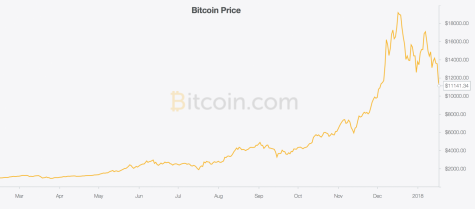Cryptocurrency Craze
Bitcoin at Parker and Beyond
Cryptocurrencies have finally taken hold of the wallets and minds of some Parker students–as they have with so many other individuals around the world.
A cryptocurrency is a monetary exchange system that allows individuals to transact business directly from peer to peer–without a third party administrator or intermediary. Transactions can occur more seamlessly this way because users do not have to report their activity to a central bank.
For investors who keep their money with large banks, there is a significant degree of oversight. “Cryptocurrencies can be advantageous for investors who do not want large corporations like Chase or BMO to control their assets,” senior and cryptocurrency advocate Jett Bronstein said. “There is more investing independence in cryptocurrencies.”
Bitcoin, perhaps the most well-known cryptocurrency, has risen in popularity because of both its ascension in market price and its extreme volatility, according to “The Wall Street Journal.”

A chart depicting Bitcoin’s fluctuation in relation to the US Dollar.
Created in 2009 by an unknown group or individual by the alias of Satoshi Nakamoto, Bitcoin–its purpose, its volatility, and its worth–grew into a complicated concept for even the most experienced of investment professionals, according to “The New York Times.”
Though its price has increased exponentially in the last 12 months, many investors believe that Bitcoin is a failing concept. “Bitcoin is a bubble,” senior and Investment Club Co-Head Mitchell Bedows said. “People think there is a lot of value to it, and they think it’s a currency, but it doesn’t act like a currency in the market.”
Upper School History Teacher and Investment Club Faculty Advisor Kevin Conlon agrees. “People want Bitcoin today like they wanted Netscape shares in the year 2000,” Conlon said, “so the price will increase in value not because of inherent worth but because of the belief that it had value, which is a bubble in financial terms.” Some businesses have felt the impact of this surge in interest.
“The way a typical currency works is through supply and demand,” Bedows said. “Once the supply and demand are met, consumers will create what investors call ‘nodes,’ and, in our currency, a node is a dollar.”
Transactions through Bitcoin are verified through a network of nodes, which gives Bitcoin its value much as nodes in the American currency give the dollar its value. Nodes are indication of every transaction that has taken place in Bitcoin.
These nodes are stored in a public ledger–a place where all individuals who transact in Bitcoin can access the transaction history of all Bitcoin. This ledger is called a Blockchain. All cryptocurrencies are modeled on the Blockchain because it eliminates the need of an intermediary, which, in real currency, is a bank.
The Blockchain acts as Bitcoin’s security because all transactions in Bitcoin are made public in this forum. If there are any irregularities in transactions through Bitcoin, individuals will be able to see that.
According to Bedows, one can “solve” a Blockchain, a complicated mathematical or coding problem that requires immense computing strength, to obtain Bitcoin. This is called “mining” for Bitcoin, according to Investopedia. All Bitcoin users are given a 50-character identification code, so all identities are anonymous, protecting people’s safety.
“The way it works is that by solving these blockchains, you’re making the transactions more secure,” Bedows said. “If no one solves the problems, whether they be mathematical or coding-related, the chain won’t work. To incentivize people to solve these problems, they are rewarded with Bitcoin.”
It’s this complicated technology that has driven Bronstein and other Bitcoin users to invest and continue investing in cryptocurrencies.
Today, Bitcoin can be exchanged for other currency, products, or services. About 100,000 merchants allow customers to pay using Bitcoin. Between 2.9 and 5.8 million users across the world use a kind of cryptocurrency, according to a study published by Cambridge University.
Some of the products and services, though, are transacted on the Black Market illegally. Bronstein sees a different future for uses of Bitcoin. “I believe that cryptocurrencies will eventually be used for all sorts of transactions,” Bronstein said, “and not just those that are illegal.”
According to Bedows, though, part of the craze surrounding Bitcoin relates to the investing ignorance of the general public. “99.9% of people who invest in Bitcoin are not professionals,” Bedows said. “They are people who know next to nothing about investing. Virtually every financial institution has declared Bitcoin not just unstable but actually a fraud, a scam.”
What’s caused Bitcoin to gain a lot of attention is its market volatility–the price per Bitcoin that is available to the public. As of January 27, one Bitcoin had a value of $11, 406.38. From September 15 of 2017 to December 15 of 2017, the price of a single Bitcoin increased 579%, but since then has decreased by 32%.
“It’s volatile by its nature,” Bedows said. “People don’t know how to invest it because there is no proper way. With stocks or currencies, there are certain trends one can study to see how it will perform, but with Bitcoin, there is nothing to tell how it will act.”
There have also been extreme regulations on coin wallets in Asia as well, driving the price of Bitcoin down. Coin wallets are the medium for individuals who transfer cryptocurrencies into real currencies.
“I think cryptocurrencies will fluctuate tremendously this year because governments will attempt to regulate them,” Bronstein said, “but there will definitely be more long-term growth.”
While Bitcoin isn’t the only cryptocurrency available, it’s certainly the most widely used. Aetherium, Litecoin, and Ripple are three other cryptocurrencies that use the Blockchain concept, but they do not have nearly the same value of Bitcoin.
Going forward, Conlon has a good way of for others to decide whether or not to invest in Bitcoin. “Don’t invest in Bitcoin because someone told you about it,” Conlon said, “but because you truly understand it.”







